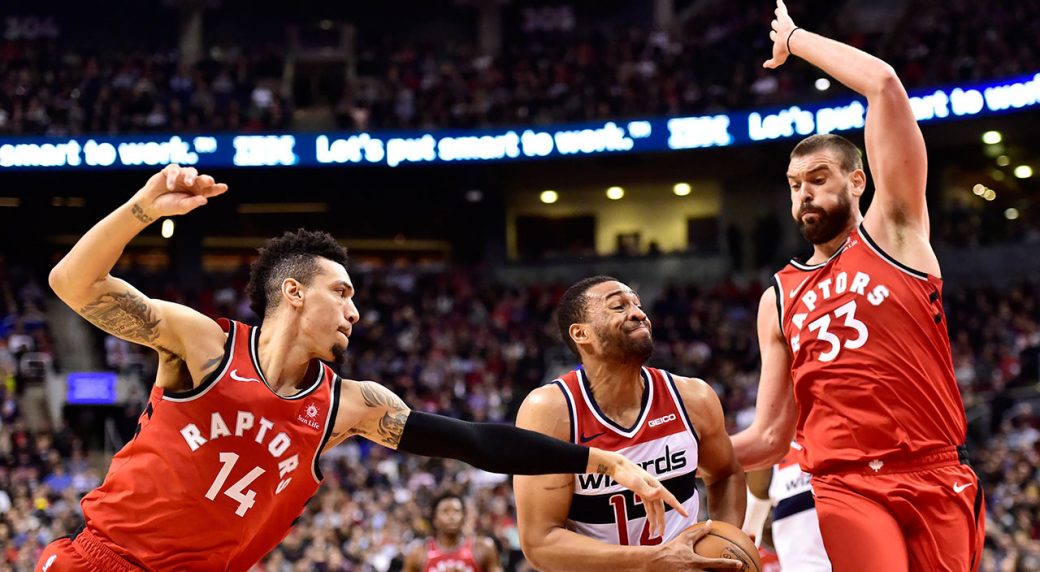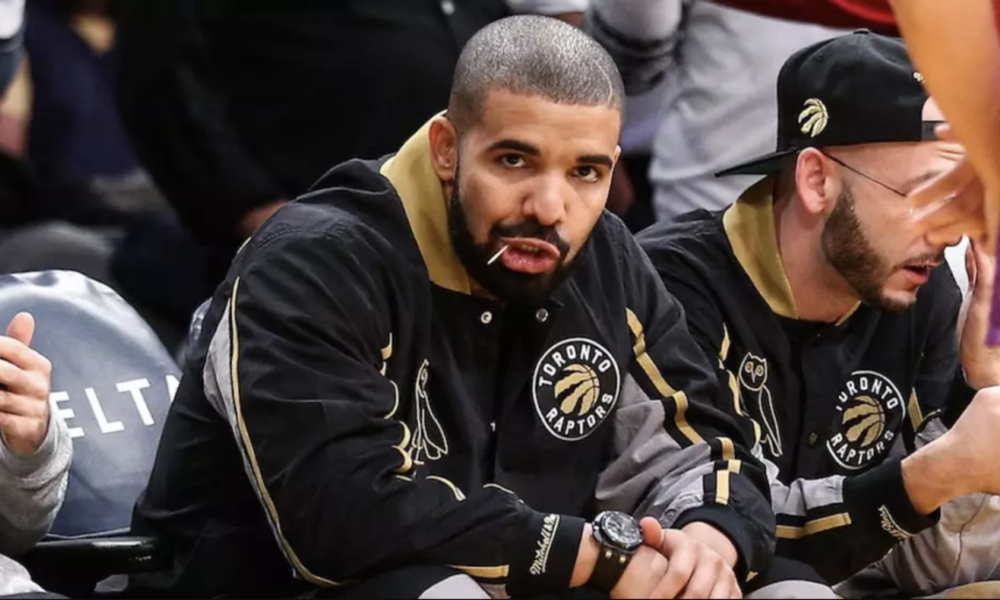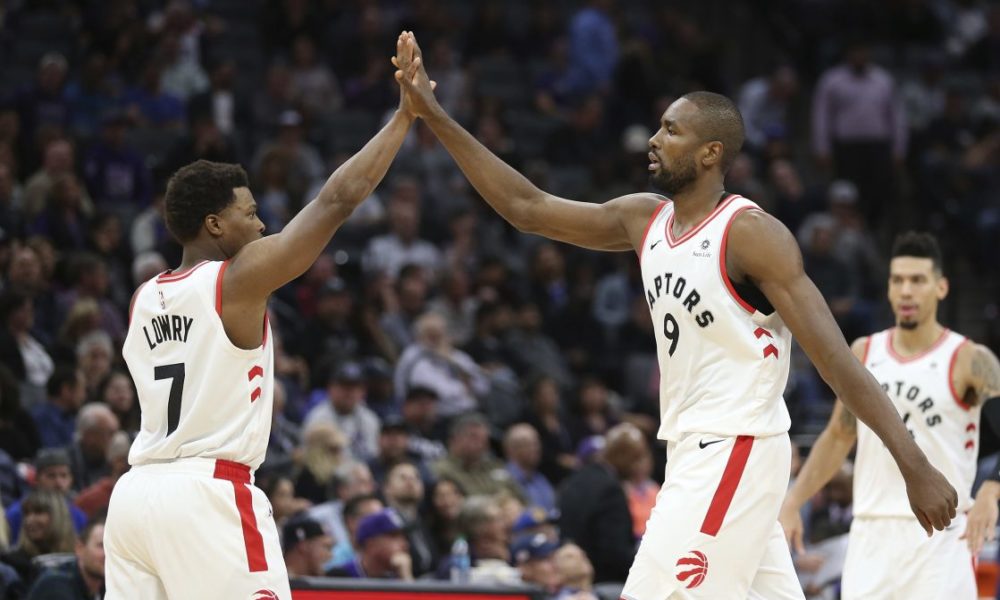Beyond the obvious macro of losing a bunch of players and adding a bunch of different players, the Toronto Raptors are playing a little bit differently since the February 7 trade deadline. They aren’t necessarily playing better, sporting a .700 winning percentage since the deadline compared to a similar .714 before. But since the deadline, and the variety or roster changes, the Raptors could be better going forward. They are shooting 3s at a better clip, passing the ball more and better, and playing in transition differently.
Before the deadline, the Raptors shot 33.3 percent from deep as a team. Since February 7, it’s been 37.7 percent, which includes a 9-for-32 performance against the Houston Rockets. The improvement is definitely caused in part by small sample sizes, as well as the aforementioned personnel change. But a variety of Raptors who were on the team before the deadline have improved from deep as well. There could be more to the shift than just a hot streak. Check out these differences in percentages.
[table id=8 /]
Also gone are Miles and Wright, who were combining to shoot 32.7 percent on 5.2 attempts per game from deep. That’s a little bit of addition by subtraction right there, and Gasol is a better shooter than Valanciunas. Green’s hilariously hot shooting is somewhat offset by some cold streaks for Jeremy Lin (0-for-17) and Kawhi Leonard (6-for-25) since the deadline.
But there is some actual change in the quality of shot the Raptors are getting from deep.
Ibaka, for example, is now wide open on 86 percent of his triples compared to ‘only’ 72 percent before the trade deadline. Siakam went from attempting 64 percent of his triples from the corner to a ridiculous 86.5 percent from the corner. (He was actually shooting 39.8 percent from the corners before the trade deadline, so shifting all of his range shots to the corners was probably an intentional coaching decision.)
Danny Green is also more open on his shots and shooting more often from the corners. Kyle Lowry is shooting more often from the corners and far more often on the catch rather than off the bounce, all per Second Spectrum tracking stats.
It’s difficult to say how much of Toronto’s improvements from deep are related to actual improvements in shot quality or shot selection. The sample size since the break is still too small to know anything with certainty. But there is enough smoke – ie, most players shooting more often from the corner, and with more space – to indicate that at least some of the improvement is due to better shots.
Of course, that begs the question: why would Toronto be getting better shots?
Part of the reason gets to the change in passing. This likely has a great amount to do with the change in personnel. Departed players Miles and Jonas Valanciunas combine to average 61.4 passes per game this season and 7.3 potential assists. By comparison Gasol and Lin dwarf those numbers, averaging 96.1 passes and 13.1 potential assists. Gasol is averaging the fifth-most passes per game league wide so far this year. (And Lowry is ahead of him.)
Correspondingly, the Raptors averaged 290.8 passes and only 24.4 assists per game before the trade deadline. Those numbers have skyrocketed to 313.1 and 28.7 since. The offence hums with more movement, more passing, and better shot selection. The result is more made 3s.
The defence has also changed somewhat. Gasol and Lin are, like Lowry, masters at taking charges. The three are all in the top-10 and have combined for 56 charges taken, which is more than any team in the NBA, and also more than the bottom four teams combined.
There’s more that’s changed with the defence than an increase in charges taken. Marc Gasol doesn’t boast the physical profiled of a turnover creating machine, but he is excellent at forcing more mistakes from opposing offences. In fact, the Raptors force 4.8 percent more turnovers with Gasol on the floor than him off. He is generally in excellent position to take away easy passes across the lane, forcing offences to try more difficult – and more easily steal-able – skip passes over the defence. In addition, Gasol himself has posted excellent block and steal rates this season, both above 2 percent. (To compare, only Nerlens Noel, DeMarcus Cousins, Andre Drummond, and Robert Covington have hit both thresholds so far this year, per CTG.)
Gasol is also great at helping create fast break opportunities without a turnover. With his quick hit-aheads, he fits fantastically beside fastbreak wizards in Siakam and Lowry. In fact, after Gasol’s 39 defensive rebounds so far as a Raptor, Toronto scores 1.23 points per possession. They are shooting 10-for-18 from deep in such scenarios, and it’s not just a hot streak, as their expected shot quality is ridiculous.. Of course, this includes Gasol’s -30 plus-minus against the Rockets. He is not the salve to any lineup combination that Leonard is, but Gasol sure does complement the Raptors in transition when he’s alongside the team’s best players.
Ibaka is more inclined to a slow pace, frequently taking one dribble before hitting his point guard after a defensive rebound, and the team scores 1.07 points per possession after Ibaka defensive rebounds. Ibaka and Gasol offer two different paces from the center position, sort of like a changeup and a fastball.
On the whole, however, Toronto’s transition attack hasn’t changed dramatically. Toronto isn’t playing faster since the deadline, with an almost identical pace. After a missed field goal, Toronto has posted an identical 1.18 points per possession, per pbpstats, before and after the trade deadline. The macro level hasn’t changed, even if some specific lineup variations options play differently.
Toronto isn’t necessarily playing better since February 7. As stated above, their winning percentage is practically the same. Toronto’s net rating has actually gotten worse since the deadline. Opponents are also attempting more 3s and hitting them at a better rate since all the roster moves. Toronto’s defensive focus from possession to possession, let alone game to game, has been problematic. While Toronto delivered a statement win over the Boston Celtics, they also lost a trio of stinkers against the Orlando Magic, Detroit Pistons, and Rockets. The point isn’t that Toronto has already hit their ceiling, but instead that the ceiling they may hit is higher now as a result of all the roster churn. And if you believe in that, there are top betting sites which will take you up on that.
Among the 20 players who have averaged 10 minutes or more per game for the Raptors, the departed ones generally sport the lowest net ratings. Miles (17th), Monroe (16th), and Wright (11th) all sported negative net ratings in a Raptors jersey. Valanciunas had a positive rating, but only the 8th-highest on the team. It’s worth mentioning that some new additions haven’t yet gelled with the team. Lin and Patrick McCaw have now stumbled to lower net ratings than any other Raptor this season. Like Ibaka and Valanciunas before him, Gasol has been excellent when starting and less good when playing with the bench. That’s a problem that needs to be addressed.
Toronto can likely play better now than they could before the trade, even if it hasn’t happened yet. They are a better shooting team and a better passing team. There are still problems to overcome, and some of those problems have been present all year. Most importantly, the bench units need fixing. The trade deadline changed a lot for Toronto, and some players who’ve been here for their whole careers are gone. But the goal was to position the team to better compete for a championship. Even if the winning hasn’t happened yet, the numbers seem to indicate that Toronto is on the right track.



